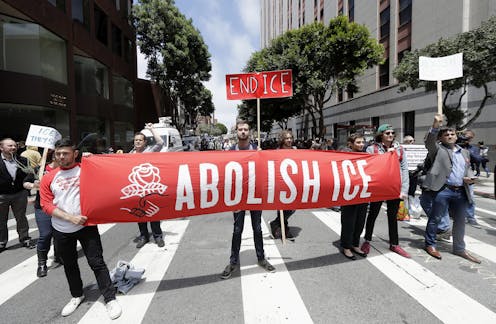Which 3-letter agency is enforcing US immigration laws at the border?
- Written by Tanya Golash-Boza, Professor, University of California, Merced

You may have heard the “Abolish ICE” slogan chanted or seen it on signs at rallies against the Trump administration’s immigration policies.
This slogan has become popular after it was reported that children were being separated[1] from their families at the border. As an immigration scholar, I have been writing[2] about immigration law enforcement for over a decade. I find the slogan somewhat counterintuitive because what is happening at the border is primarily under the purview of Customs and Border Patrol, not Immigration and Customs Enforcement.
Here’s a breakdown of which agencies are doing what to enforce immigration laws in the U.S.
Creation of ICE
In the aftermath of the terrorist attacks on Sept. 11, 2001, Congress passed the Homeland Security Act of 2002[3]. This act mandated the creation of a new Department of Homeland Security as part of a broader strategy in the “war on terrorism.”
The new department came to life in 2003 and took over all operations of the former Immigration and Naturalization Service, which had been responsible for immigration law enforcement as well as processing immigration and citizenship applications. This was the most significant transformation[4] of the federal government since the creation of the Department of Defense.
Today, the Department of Homeland Security enforces immigration laws primarily through two of its agencies: Customs and Border Patrol and Immigration and Customs Enforcement.
The Border Patrol[5] has existed as a government agency since 1924 and is primarily responsible for enforcing laws at the border. It only has jurisdiction up to 100 miles in from U.S. land borders and at ports of entry such as airports.
Immigration and Customs Enforcement was created in 2003 and is primarily responsible for enforcing immigration laws in the rest of United States. The other immigration agency within Homeland Security is U.S. Citizenship and Immigration Services, which processes applications for immigration and citizenship. Prior to the creation of the Department of Homeland Security, immigration enforcement and application processing were managed by divisions of the Immigration and Naturalization Service.
Follow the money
The creation of the Department of Homeland Security changed immigration law enforcement in two ways.
First, it transferred immigration law enforcement from the Department of Justice to Homeland Security. This transition solidified the perception of immigration law enforcement as an integral part of national security[6]. The link between immigration and terrorism is not new, but it has become amplified in the fight against terrorism.
Second, it entailed a massive infusion of money into immigration law enforcement. ICE’s current budget[7] of US$7.9 billion is larger than the entire budget of the INS. In 2002, the INS’ last year of existence, its budget was $7.2 billion in 2018 dollars.
Custom and Border Patrol’s budget is even bigger at $16.4 billion. These funds support 20,258 border agents – an all-time record, despite record low numbers[8] of people trying to illegally enter the United States.
President Donald Trump’s 2017 executive order[9] on immigration enforcement mandated a tripling of ICE agents from 5,000 to 15,000 agents. However, the 2018 DHS budget only includes funding for 1,000 additional ICE agents. Congress has been unwilling to fund[10] more.
Enforcement and deportations
Critics of the Trump administration have taken to the streets to protest immigration policy in far greater numbers than they did during the Obama administration. Immigration is a central component of Trump’s platform. However, the number of deportations during the current administration is far lower than under President Barack Obama[11].
Obama presided over record-high numbers of deportations. Some 3 million people[12] total were deported during the Obama administration[13] – more than any previous administration and at a far higher rate than that of the current administration.
For the past 20 years, aggressive immigration law enforcement has been a constant across Democrat and Republican administrations. Democratic President Bill Clinton signed laws[14] in 1996 that greatly expanded deportations. Republican George Bush created the Department of Homeland Security and, in effect, ICE. The creation of the Department of Homeland Security led to a spike in the number of people deported from the U.S.
The number of people taken into custody[15] by ICE increased throughout the first term of the Obama administration, declined during Obama’s second term, and has begun to increase again. Presently, ICE apprehensions are about half[16] what they were during the peak of the Obama administration. Data on ICE apprehensions provide a good sense of immigration law enforcement efforts inside the United States, while data on Border Patrol apprehensions provide a good measure of how many people are attempting to illegally enter the United States across a land border.
It is extremely unlikely that the Trump administration will abolish ICE. Protesters against Trump’s immigration policies are part of a broader trend of high turnout[17] at protests under his administration. There will likely continue to be plenty for immigration rights advocates to protest.
References
- ^ children were being separated (www.vanityfair.com)
- ^ writing (scholar.google.com)
- ^ Homeland Security Act of 2002 (www.dhs.gov)
- ^ significant transformation (books.google.com)
- ^ Border Patrol (www.ucpress.edu)
- ^ national security (books.google.com)
- ^ current budget (www.dhs.gov)
- ^ record low numbers (theconversation.com)
- ^ 2017 executive order (www.whitehouse.gov)
- ^ unwilling to fund (www.govexec.com)
- ^ lower than under President Barack Obama (www.bloomberg.com)
- ^ 3 million people (www.migrationpolicy.org)
- ^ Obama administration (www.economist.com)
- ^ signed laws (books.google.com)
- ^ taken into custody (trac.syr.edu)
- ^ about half (trac.syr.edu)
- ^ trend of high turnout (www.vox.com)
Authors: Tanya Golash-Boza, Professor, University of California, Merced


